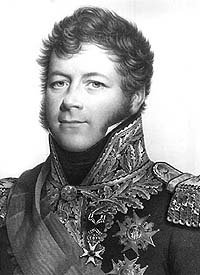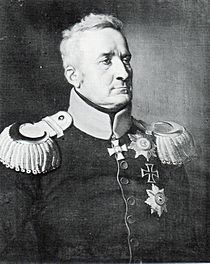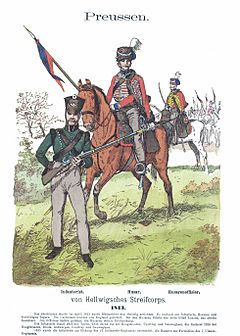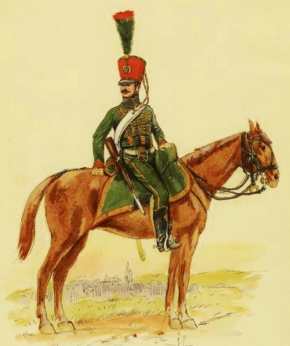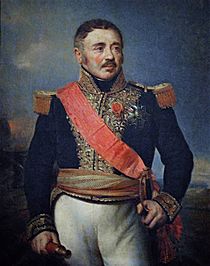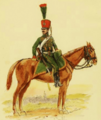Battle of Courtrai (1814) facts for kids
Quick facts for kids Battle of Courtrai (1814) |
|||||||
|---|---|---|---|---|---|---|---|
| Part of War of the Sixth Coalition | |||||||
|
|||||||
| Belligerents | |||||||
| Commanders and leaders | |||||||
| Units involved | |||||||
| Strength | |||||||
| 9,500-13,000 35–36 guns |
3,800–9,000 6–7 guns |
||||||
| Casualties and losses | |||||||
| 300-800 | 900–1,908 2–3 guns lost |
||||||
The Battle of Courtrai happened on March 31, 1814. It was a fight between French forces led by General Nicolas Joseph Maison and Saxon (German) and Prussian troops. The battle took place near Kortrijk (also called Courtrai) in what is now Belgium.
General Johann von Thielmann's Saxon troops attacked, but they ran into a much larger French army. Many of the Saxon soldiers were fighting for the first time. The battle ended with the Saxons being defeated and forced to retreat.
This battle was part of a bigger conflict called the War of the Sixth Coalition. While Napoleon fought major battles in France, another part of the war was happening in the Low Countries (modern-day Belgium and Netherlands). Here, a group of countries allied against France tried to push out the French army.
The allied forces, including British troops, managed to push the French back to Lille. They also trapped many French soldiers in the city of Antwerp. General Maison, despite being outnumbered, made a bold move. He marched his army from Lille to Antwerp, picked up more soldiers, and then moved south again. He defeated Thielmann's Saxon army in this battle. The war ended soon after, when Napoleon gave up his power on April 6, 1814.
Contents
How the Battle Started
Winter Fights in the Low Countries
In late 1813, a large Allied army, called the Army of the North, was ready to invade the Low Countries. This army included soldiers from Russia and Prussia. On November 23, 1813, Prussian troops crossed into the Netherlands.
They quickly freed northern Holland from French control. On December 4, British troops joined them. However, the Allied efforts slowed down because some commanders didn't work well together.
Napoleon put General Nicolas Joseph Maison in charge of the French forces in the Netherlands. Napoleon wanted Antwerp to be strongly defended with 30,000 soldiers. But Maison only had about 10,000 troops there.
In January 1814, the Prussians won a few small battles against Maison's troops. But Antwerp's defenses were too strong, so the Prussians pulled back. Other Allied forces also moved slowly.
On February 1, Maison left Brussels and retreated to Lille with about 4,000 soldiers. He left some troops to defend Antwerp. The Allied forces then moved south to join the main armies fighting Napoleon in France.
Spring Movements and Skirmishes
General Maison's army was quite small, with only about 6,600 men. Many of these were new recruits who were not well-equipped. Maison had to use most of them to guard cities, leaving him with only about 1,100 extra soldiers for his main fighting force.
On March 21, 1814, Maison faced an attack by Saxon troops led by Johann von Thielmann. After some fighting, the Saxons were pushed back. French cavalry even captured some Saxon soldiers.
By late March, Maison's army had about 7,100 soldiers. He wanted more troops, so he ordered the commander in Antwerp to prepare a division to join him. When Maison heard that the Duke of Saxe-Weimar (an Allied commander) was busy attacking another city, he saw his chance.
On March 25, Maison's army left Lille. They quickly defeated a Prussian force near Menen. Maison sent a small part of his army east to make the Allies think he was heading in a different direction. This was a clever trick to hide his real plan.
On March 26, Maison's main army surprised the defenders of Ghent. They captured the city and took many Belgian soldiers prisoner. Maison decided not to treat the Belgians as traitors, even though they were legally French citizens at the time. He sent a message to Antwerp, ordering more troops to join him.
On March 27, about 4,000 infantry, 260 cavalry, and 14 cannons from Antwerp joined Maison's army. This brought his total strength to about 9,700 foot soldiers, 1,360 horsemen, and 35 cannons.
General Thielmann realized Maison was trying to make his army stronger. But Thielmann's superior, the Duke of Saxe-Weimar, thought Maison wanted to attack Brussels. Maison encouraged this idea by spreading false rumors.
Allied troops then reoccupied some towns. However, Thielmann was the real danger to Maison, as he had about 12,000 troops. On March 30, Maison left Ghent and marched southwest along the Leie River. He sent a division to cover his movement. His army then reached Courtrai, which the Prussians left when they saw the French approaching.
The Battle Unfolds
When Thielmann found out Maison had left Ghent, he moved southwest, hoping to catch a part of Maison's army. He gathered his scattered troops and asked another Allied commander to help him defeat the French.
On March 31, at 6:00 AM, Thielmann's troops pushed back French outposts near Zwevegem. Thielmann and his officers went forward to see the French battle line. After checking, Thielmann ordered his troops to attack.
Maison saw that the Saxons were only attacking from one direction. He decided to surround them from both sides. He ordered one of his divisions to attack the Saxon left side and another to attack their right side. His other divisions would hold the center.
Maison's soldiers were more experienced than the Saxons. The French units had many veteran soldiers, while the Saxon Landwehr (a type of militia) had never fought in a battle before.
The Saxons attacked, but Maison quickly responded. He sent French skirmishers (soldiers who fight in a loose formation) to hit the Saxon left side. He also sent four battalions forward, pushing back the Saxon lines.
When Thielmann finally realized he was fighting Maison's entire army, he immediately ordered a retreat. The Saxon cavalry tried to help their infantry escape. But as the French divisions closed in from both sides, the Saxon army started to fall apart.
French cavalry charged, breaking through the Saxon lines. Thielmann's formations broke up, and individual Saxon soldiers ran in all directions. Some Saxon battalions were trapped and had to surrender. Many panicked Saxons even drowned trying to cross the Scheldt River.
What Happened Next
The French had fewer casualties, losing about 300 to 800 men. The Saxons suffered much heavier losses, with about 900 to 1,908 soldiers killed, wounded, or captured. They also lost two or three cannons. Many Saxon units were severely weakened after the battle.
After the battle, Maison sent his divisions towards Tournai. He bombarded the Allied soldiers in Tournai to distract them. This allowed his slow-moving supply wagons to reach Lille safely.
Meanwhile, other Allied forces tried to reoccupy Ghent and Courtrai. But Maison was still outnumbered overall. He had no choice but to leave Courtrai and retreat back to Lille.
Maison then moved towards Valenciennes to disrupt the Allied supply lines. On April 5, he learned that Paris had been captured by the Allied forces. Napoleon had lost the Battle of Paris on March 30 and gave up his power on April 6. Maison and Thielmann agreed to stop fighting on April 7, and the war in that area was over.
Images for kids


